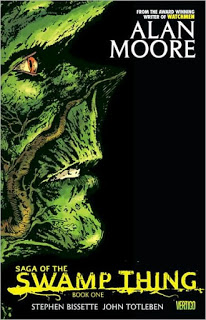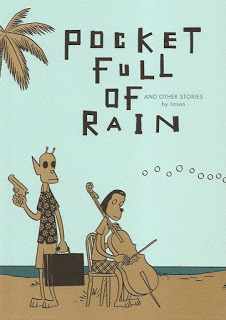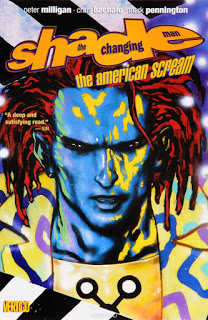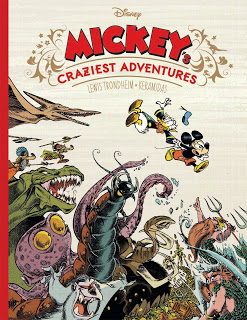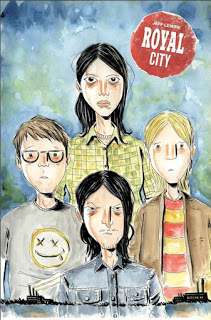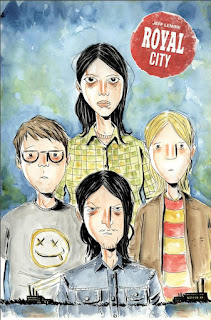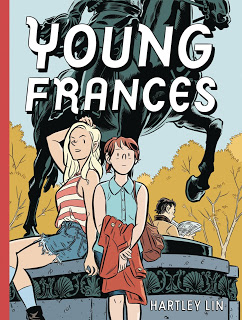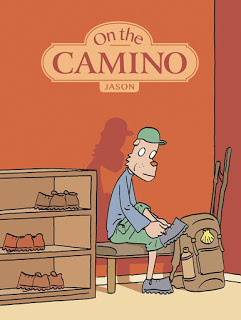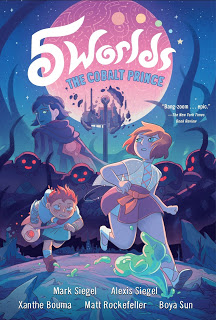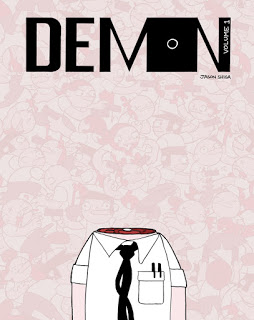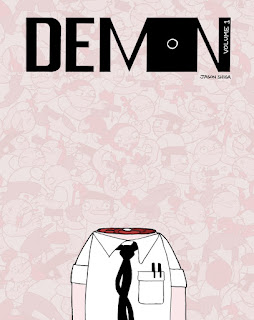Book-A-Day 2018 #202: Saga of the Swamp Thing by Alan Moore and various artists (6 volumes)
I wouldn’t say that all of modern mainstream comics comes from Alan Moore’s Swamp Thing. Frank Miller’s work on Daredevil and The Dark Knight was just as influential, alongside the Claremont X-Men and the event frenzy kick-started by the Wolfman/Perez Crisis. And there have certainly been major developments in the thirty years since then. But our modern adventure-story comics world was formed in those days of the mid-80s when the Direct Market was strong and growing, when the outside world was reading “comics are growing up” stories every few months (with new examples each time), and the expectations of both readers and publishers started to bend to shocking revelations and long story arcs and Worlds That Would Never Be the Same. And that world was strongly molded by Alan Moore, starting with Swamp Thing in late 1983.
Thirty-plus years later, those Moore stories are both shockingly modern and shockingly old-fashioned: cold-eyed about humanity and the place of superbeings alongside it, but utterly besotted with their own wordy narration. These are intensely told stories: Moore in the ’80s was the culmination of Silver Age style, all captions and explanations and background and atmosphere, cramming all of his ideas and poetic descriptions into each twenty-three page issue, exhausting every concept as soon as he introduced it.
Swamp Thing, the character, was a scientist named Alec Holland, working on a “bio-restorative formula” with his also-scientist wife in what looked like a barn deep in the Louisiana marshes. (This all made sense in the early 1970s, when ecology and back-to-the-land were huge.) The usual evil forces of international business sabotaged his work: his wife was killed and Alec, permeated with the formula and burning to death from an explosion, fell into the swamp. He arose, a few days later, as the slow-talking Swamp Thing, to stop those evil businessmen and battle weird menaces around the world for at least the duration of the early-70s horror boom. His first comics series ended after 24 issues of slowly dwindling sales and quickly increasing gimmicks to try to reverse the sales drop, and was revived about a decade later when a cheap movie adaptation came out. The same slow-death started setting in, with similar results, and the second series began to look like it would run only about as long as the first.
And then Alan Moore took over writing what was then Saga of the Swamp Thing from Martin Pasko with issue #20. His first outing was a clean-up effort, tying off “Loose Ends” from the Pasko run, like a concert pianist running a few scales to warm up before diving into the meat of the program. A month later, he delivered one of the most influential and iconic single issues of any comic, “The Anatomy Lesson,” where he carefully explained that Swamp Thing’s origin and explanation made no sense whatsoever, and started the path to what he declared was a better foundation for the character. (He was right, and he shouldn’t be blamed that a thousand others have tried to do the same thing to a thousand other characters since then, with not necessarily the same level of rigor or success.)
 Before long, the title had simplified to Swamp Thing — the same as that original Len Wein/Bernie Wrightson series a decade before — grown the tag-line “Sophisticated Suspense,” and quietly become the first Big Two comic to ditch the Comics Code seal. It was also a huge hit, both critically and commercially. By the time Moore ended his run on Swamp Thing with #64, almost four years later, the Crisis had come and gone, he was in the middle of Watchmen, and the landscape of American comics had been radically changed.
Before long, the title had simplified to Swamp Thing — the same as that original Len Wein/Bernie Wrightson series a decade before — grown the tag-line “Sophisticated Suspense,” and quietly become the first Big Two comic to ditch the Comics Code seal. It was also a huge hit, both critically and commercially. By the time Moore ended his run on Swamp Thing with #64, almost four years later, the Crisis had come and gone, he was in the middle of Watchmen, and the landscape of American comics had been radically changed.
(As a sidebar, it’s interesting to note that the editor on those early Moore Swamp Thing issues was Wein himself — it’s a fantastic example of a creator nurturing stories that reinterpret, even replace, the work he did earlier.)
That Swamp Thing run was one of the first to be collected in a comprehensive way soon after periodical publication, as the comics industry started to realize what the book industry had known for several generations: a creative property you can keep selling in a fixed form for years is vastly more valuable than creative properties that you need to refresh every month. The complete Alan Moore run is currently available as six trade paperbacks, under the overall title The Saga of the Swamp Thing , reprinting all forty-five issues with introductions by various people. (Not including Moore, though, as anyone who has heard about his contentious relationship with DC Comics since will expect.) If you’re looking for those books individually, have some links: one , two , three , four , five , six .
The first thing to note is that the divisions between books generally make sense: they each collect eight issues, except Book Five has only six, and they tend to break at important moments. This is partially an artifact of comics-storytelling norms of the time: then, a three-issue story was an epic, and anything longer than that was remarkable. (Of course, subplots would run longer than that — I mentioned Claremont up top, and he’s one of the major originators of the throw-in-hints-of-the-next-four-stories-in-each-issue plotting style — but the actual conflict in any issue would be done within fifty or seventy pages nearly all the time.) But Swamp Thing also tended to run to story arcs, more and more as Moore wrote it; it’s one of the origins of that now-common structure. So it’s partially luck, partially planning, and partially the nature of these stories that makes them break down as cleanly as they do into volumes. It means that a reader can come to this series thirty years later — it’s now impossible to come to it any earlier, if you haven’t already — and take it one book at a time, as her interest is piqued. (Or you can run through all of them quickly, as I did.)
Book One leads off with #20, “Loose Ends” — not generally included in Swamp Thing reprints for the first decade or so, as DC presumably wanted to start with the bigger bang of “The Anatomy Lesson” — and runs through the continuation of that story with Jason Woodrue and then a three-part story featuring Jack Kirby’s The Demon. These are the foundational stories, in which Moore resets everything about the series: tone, cast, mood, atmosphere, even genre. (There were horror elements in the earlier stories, obviously, but Moore moved it definitively from “superhero story with horror villains” to “horror story with a muckmonster hero.”) The Woodrue story also has a nice cameo by the Justice League, cementing Swampy’s place in the “real” DC Universe. Swamp Thing, and the Vertigo imprint that eventually grew out of it, would have a complicated relationship with that continuity over the next few decades — as that continuity itself got more complex and self-referential, in part driven by the work Moore did here and other writers did in a similar vein — but, when it began, it was just the weird corner of the same universe.
 Book Two is anchored by the return of Anton Arcane, Swampy’s greatest villain, who Moore made even more infernal as he threw Arcane into Hell and brought him (briefly) back. I’m not sure if this is the first time we get an extended look at DC Comics Hell — there were a bunch of vaguely Satanic comics in the ’70s, though mostly on the Marvel side — but Moore’s vision of Hell, as amplified and extended a few years later by Neil Gaiman in the early issues of Sandman, was the model for DC for a generation from this point. This second book also has the first visual breaks from the main look for the Moore run: the majority of the early Moore issues are pencilled by Stephen Bissette and inked by John Totleben, but they have a very detailed, intricate style and Swamp Thing also tended to have heavily designed pages — which all added up to mean that getting twenty-three pages done, at that level and in that style, tended to take longer than the month between issues. So this volume has two issues drawn by Shawn McManus: the first a coda to the storyline of the first volume, the second a homage to Walt Kelly’s Pogo. And another issue reprinted here brings back Cain and Abel, the mystery hosts from DC’s horror-anthology comics of the early ’70s, in a framing story drawn by Ron Randall to showcase the original short “Swamp Thing” comic by Wein and Wrightson that served as a tryout and model for the ’70s series.
Book Two is anchored by the return of Anton Arcane, Swampy’s greatest villain, who Moore made even more infernal as he threw Arcane into Hell and brought him (briefly) back. I’m not sure if this is the first time we get an extended look at DC Comics Hell — there were a bunch of vaguely Satanic comics in the ’70s, though mostly on the Marvel side — but Moore’s vision of Hell, as amplified and extended a few years later by Neil Gaiman in the early issues of Sandman, was the model for DC for a generation from this point. This second book also has the first visual breaks from the main look for the Moore run: the majority of the early Moore issues are pencilled by Stephen Bissette and inked by John Totleben, but they have a very detailed, intricate style and Swamp Thing also tended to have heavily designed pages — which all added up to mean that getting twenty-three pages done, at that level and in that style, tended to take longer than the month between issues. So this volume has two issues drawn by Shawn McManus: the first a coda to the storyline of the first volume, the second a homage to Walt Kelly’s Pogo. And another issue reprinted here brings back Cain and Abel, the mystery hosts from DC’s horror-anthology comics of the early ’70s, in a framing story drawn by Ron Randall to showcase the original short “Swamp Thing” comic by Wein and Wrightson that served as a tryout and model for the ’70s series.
Book Three is the bulk of the “American Gothic” storyline, introducing John Constantine — who has gone on to fame on his own, with a very long-running comic and a movie that was at least higher-budget than any of Swampy’s — and sending Swampy cross-country to see and confront growing horrors in the world: nuclear waste, racism, sexism, and (of course) aquatic vampires. Here the art continues to move around a small team: Rick Veitch pencils one issue (he also helped out on some pages in two issues in the first volume), Alfredo Alcala inks another, and Stan Woch pencils a third. The team is clearly moving resources around to maintain a consistent visual look and at the same time maintain that punishing monthly deadline. These stories are the heart of Swamp Thing as a horror comic: Moore is taking individual concerns of the then-modern world (mostly; the aquatic vampires aren’t particularly emblematic of anything) and showing how they can be twisted and made horrible.
 Book Four finishes up “American Gothic,” which leads into the double whammy of Crisis and Swamp Thing‘s own fiftieth issue, which was explicitly positioned in the story as a crisis after the Infinite Earths one. (Evil South American wizards — the same ones mentioned in Bruce Chatwin’s In Patagonia
, which I coincidentally read recently — knew the whole “worlds will live, worlds will die” thing was coming, and planned to summon Primordial Darkness to take over Heaven in the tumult.) This is one of Moore’s largest-scale stories, and from that era when he aspired to write big superhero-universe crossovers: Watchmen started out that way, and the aborted Twilight of the Superheroes project from 1987 was an even bigger take on the same idea. So Swampy almost becomes a supporting character in his own book, with the Demon and the Phantom Stranger and Deadman and the Spectre and Dr. Fate and John Constantine with a roomfull of minor DC magicians all demanding their time in the spotlight. It does all come together, and tells a strong story — even if the ending is strangely muted, with characters explicitly saying things like:
Book Four finishes up “American Gothic,” which leads into the double whammy of Crisis and Swamp Thing‘s own fiftieth issue, which was explicitly positioned in the story as a crisis after the Infinite Earths one. (Evil South American wizards — the same ones mentioned in Bruce Chatwin’s In Patagonia
, which I coincidentally read recently — knew the whole “worlds will live, worlds will die” thing was coming, and planned to summon Primordial Darkness to take over Heaven in the tumult.) This is one of Moore’s largest-scale stories, and from that era when he aspired to write big superhero-universe crossovers: Watchmen started out that way, and the aborted Twilight of the Superheroes project from 1987 was an even bigger take on the same idea. So Swampy almost becomes a supporting character in his own book, with the Demon and the Phantom Stranger and Deadman and the Spectre and Dr. Fate and John Constantine with a roomfull of minor DC magicians all demanding their time in the spotlight. It does all come together, and tells a strong story — even if the ending is strangely muted, with characters explicitly saying things like:
Happened? Nothing has happened. Everything has happened. Can’t you feel it? Everywhere things look the same, but the feeling…the feeling is different.”
One can admire Moore’s writing and plotting and still think this is a remarkably deflating denouement.
Book Five is another group of transitional stories. First, because the art team switches to Veitch and Alcala, except for one issue in the middle drawn entirely by Totleben. And, more importantly, because it moves from the aftermath of the “spiritual Crisis” through the arrest and prosecution of Swampy’s girlfriend Abby in Gotham City — and Swampy’s subsequent assault on that city through a massive green-ification project — before Swampy sets off, unexpectedly and not by choice, on his next story arc. At the risk of spoiling thirty-five year old stories, he’s catapulted off into space, where he needs to learn how to modulate his wavelengths (more or less) to get back home.
 And Book Six is when he does so. By this time, Moore was also working on Watchmen, and was getting to the point where he’d nearly said all he wanted to say with Swamp Thing. So this last volume has stories explicitly planned as transitions to the story-sequence that would follow: Rick Veitch would take over writing (on top of pencilling), and so he writes one story here. Bissette writes another, a sidebar set back on Earth, in which Abby is reunited, for one last time, with her ill-fated father. One issue has a quite experimental art style from Totleben, all chilly mecanico-organic forms, and the big conclusion is something of a jam issue, with art from nearly everyone who contributed to the Moore run: Bissette, original Saga penciller Tom Yeates, Veitch, and Alcala, under a Totleben cover.
And Book Six is when he does so. By this time, Moore was also working on Watchmen, and was getting to the point where he’d nearly said all he wanted to say with Swamp Thing. So this last volume has stories explicitly planned as transitions to the story-sequence that would follow: Rick Veitch would take over writing (on top of pencilling), and so he writes one story here. Bissette writes another, a sidebar set back on Earth, in which Abby is reunited, for one last time, with her ill-fated father. One issue has a quite experimental art style from Totleben, all chilly mecanico-organic forms, and the big conclusion is something of a jam issue, with art from nearly everyone who contributed to the Moore run: Bissette, original Saga penciller Tom Yeates, Veitch, and Alcala, under a Totleben cover.
It all ends on a happy note: Swampy is back where he belongs, having learned more about himself and the universe and having found something like peace. If the series had ended there, it would have been an ending — but popular comics didn’t end in 1987 just because they had a good place to do so.
Instead, the next month there was a Veitch-Alcala issue, launching a new plot arc. Veitch continued the concerns and manner of the Moore run — though with somewhat less of the overwrought narration, which was becoming outmoded even in the late ’80s — but ran afoul of DC brass a little over a year later, during a time-travel storyline that was to culminate with Swampy meeting a certain religious leader in Roman-occupied Palestine.
But that’s all another story: a story not collected in the books I’m writing about here, and in fact never collected, since it was cancelled and twisted and broken in the process.
Moore wrote forty-three issues of Swamp Thing over a four-year period, including at least three double-length issues (and, again, Veitch and Bissette also each contributed one script as part of the overall plot line). He worked with a team that ended up being fairly large — Bissette, Totleben, Veitch, and Alcala most of the time, McManus and Randall and Yeates and Dan Day stepping in here and there. But the whole thing does hang together — it’s not quite one story, but it’s a closely related cluster of stories, with consistent themes and concerns, that took a fairly conventional “weird hero” and turned him and his world into something new and strange in American comics.
Others have built on this foundation since then: most obviously, Neil Gaiman with Sandman, who got the luxury of a real ending and who was able to take a stronger hand at choosing art teams to go with specific story sequences. But Sandman could not have happened without the Moore Swamp Thing, as a thousand other comics could not have happened — all of Vertigo, for example, and most of what Image currently publishes, and Mike Mignola’s Hellboy universe, among many others.
Modern readers might find the Moore Swamp Thing much wordier than they expect: he was the last great Silver Age writer, a decade or two out of his time, when he wrote these comics. They’re all good words, deployed well and to strong effect — but we have to admit there are a lot of them. The coloring is also clearly ’80s vintage: very strong for its time, and pushing the limits of what could be done with newsstand comics in those days long before desktop publishing, but still clearly more limited and bold than what we’re used to today.
All those things are inherent in reading older stories. And all stories are “older” before too long. The strong stories are worth the effort — frankly, even new strong stories require some effort, since that’s one of the main things that makes them strong.
You should read the Alan Moore Swamp Thing, if you have any interest in comics or horror or superhero universes or ecology in literature or spirituality or transcendence. If you’re not interested in any of those things, well, it sounds like a dull life, but good luck with it.
![]()
![]()
Reposted from The Antick Musings of G.B.H. Hornswoggler, Gent.

